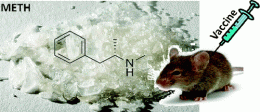Toward a vaccine for methamphetamine abuse

Scientists are reporting development of three promising formulations that could be used in a vaccine to treat methamphetamine addiction — one of the most serious drug abuse problems in the U.S. The report appears in the Journal of the American Chemical Society.
In the paper, Kim Janda and colleagues note that methamphetamine use and addiction cost the U.S. more than $23 billion annually due to medical and law enforcement expenses, as well as lost productivity. The drug, also called "meth" or "crystal meth," can cause a variety of problems including cardiovascular damage and death. Meth is highly addictive, and users in conventional behavioral treatment programs often relapse. Previously tested meth vaccines either are not effective or are very expensive. To overcome these challenges, the researchers made and tested new vaccine formulations that could potentially be effective for long periods, which would drive down costs and help prevent relapse.
The group found that three of the new formulations that produced a good immune response in mice (stand-ins for humans in the lab) were particularly promising. "These findings represent a unique approach to the design of new vaccines against methamphetamine abuse," say the researchers.
More information: “Impact of Distinct Chemical Structures for the Development of a Methamphetamine Vaccine” J. Am. Chem. Soc., 2011, 133 (17), pp 6587–6595 DOI: 10.1021/ja108807j
Abstract
(+)-Methamphetamine (METH) use and addiction has grown at alarming rates over the past two decades, while no approved pharmacotherapy exists for its treatment. Immunopharmacotherapy has the potential to offer relief through producing highly specific antibodies that prevent drug penetration across the blood−brain barrier thus decreasing reinforcement of the behavior. Current immunotherapy efforts against methamphetamine have focused on a single hapten structure, namely linker attachment at the aromatic ring of the METH molecule. Hapten design is largely responsible for immune recognition, as it affects presentation of the target antigen and thus the quality of the response. In the current paper we report the systematic generation of a series of haptens designed to target the most stable conformations of methamphetamine as determined by molecular modeling. On the basis of our previous studies with nicotine, we show that introduction of strategic molecular constraint is able to maximize immune recognition of the target structure as evidenced by higher antibody affinity. Vaccination of GIX+ mice with six unique METH immunoconjugates resulted in high antibody titers for three particularly promising formulations (45−108 μg/mL, after the second immunization) and high affinity (82, 130, and 169 nM for MH2, MH6, and MH7 hapten-based vaccines, respectively). These findings represent a unique approach to the design of new vaccines against methamphetamine abuse.
Provided by American Chemical Society















